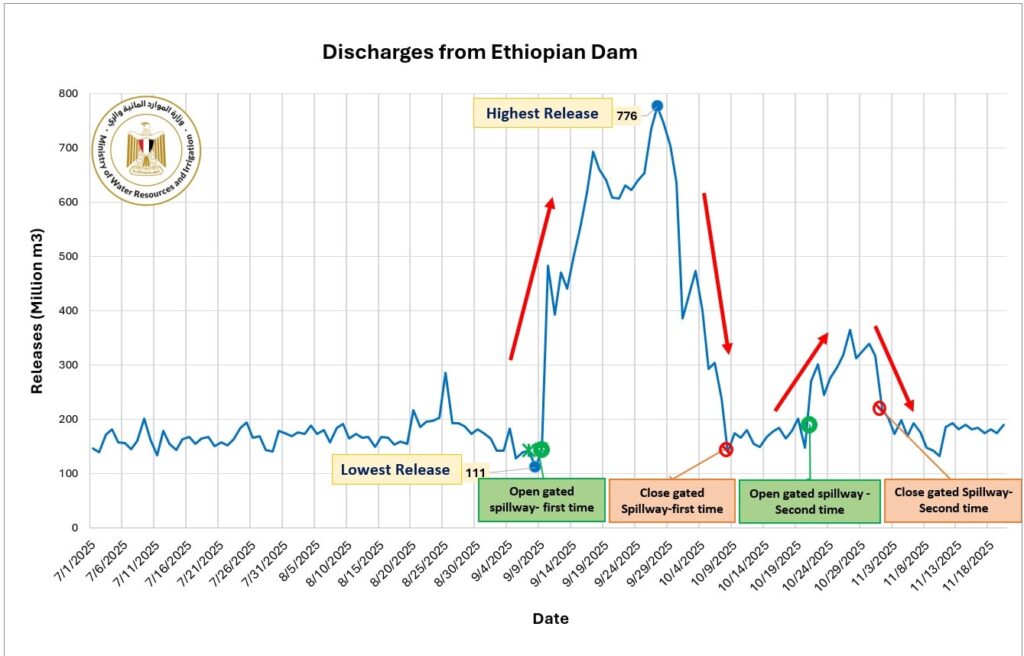Egypt Raises Concerns Over Ethiopia’s Management of the Grand Ethiopian Renaissance Dam
Introduction
Egypt has voiced serious concerns regarding the management of the Grand Ethiopian Renaissance Dam (GERD), accusing Ethiopia of operating the dam in an “unilateral and hydrologically inconsistent” manner. Recent irregular water releases have led to significant fluctuations along the Blue Nile, prompting Egypt to take necessary actions to stabilize its water systems.
Water Release Irregularities
On September 10, 2025, the Ethiopian authorities released approximately 485 million cubic meters of water from the GERD. This release was followed by an abrupt increase to 780 million cubic meters on September 27. Such sudden changes caused the lake levels to drop by nearly one meter, translating to a loss of roughly 2 billion cubic meters of water. By September 30, the outflows had decreased to about 380 million cubic meters.
Importance of Controlled Releases
The Egyptian Ministry of Water Resources and Irrigation highlighted that internationally accepted guidelines for dam operations stipulate a gradual reduction of reservoir levels from 640 meters to about 625 meters by the close of the hydrological year. Instead, Ethiopia has reportedly closed the GERD’s emergency spillway on October 8, reducing water discharges to 139 million cubic meters and averaging just 160 million cubic meters per day until October 20.
Erratic Release Patterns
Officials from Egypt noted that the inconsistent release patterns—characterized by sharp reductions to increase water storage followed by abrupt, large discharges that significantly exceed operational needs—illustrate a lack of a stable and technically sound operating plan from Ethiopia.
On October 21, the situation escalated as outflows surged unexpectedly to 300 million cubic meters after Ethiopia reopened the emergency spillway, which is meant for exceptional circumstances. Following this, water releases stabilized at around 320 million cubic meters daily for the next ten days before the spillway was again closed on October 31.
Effects on Downstream Operations
From November 1 to 20, discharges from the dam rose to an average of 180 million cubic meters per day, significantly above the historical norm of 100 million cubic meters for this period. This volatility has created challenges for upstream dams, which necessitate precautionary measures to manage sudden inflows effectively.
Egypt’s Strategic Response
In response to these operational challenges, the Nile Revenue Committee, responsible for continuous monitoring using hydrological models and satellite data, decided to open the Toshka spillway. This action aims to absorb excess water and stabilize Egypt’s water system while also delaying planned expansion works on the spillway’s discharge capacity.
Despite the unpredictable releases from GERD, Egypt has declared that its water system remains “fully stable and under control.” The High Aswan Dam continues to serve as the nation’s primary safeguard, effectively mitigating the risks posed by erratic upstream water releases.
Conclusion
Egypt’s assertion that Ethiopia’s management of the Grand Ethiopian Renaissance Dam lacks a stable operational plan highlights urgent concerns over regional water security. The ongoing dialogues and interventions will be critical in managing the water resources of the Nile River, ensuring the well-being of millions who depend on its flows. For more details on dam operations and strategies, refer to resources from the World Bank and Nile Basin Initiative.
